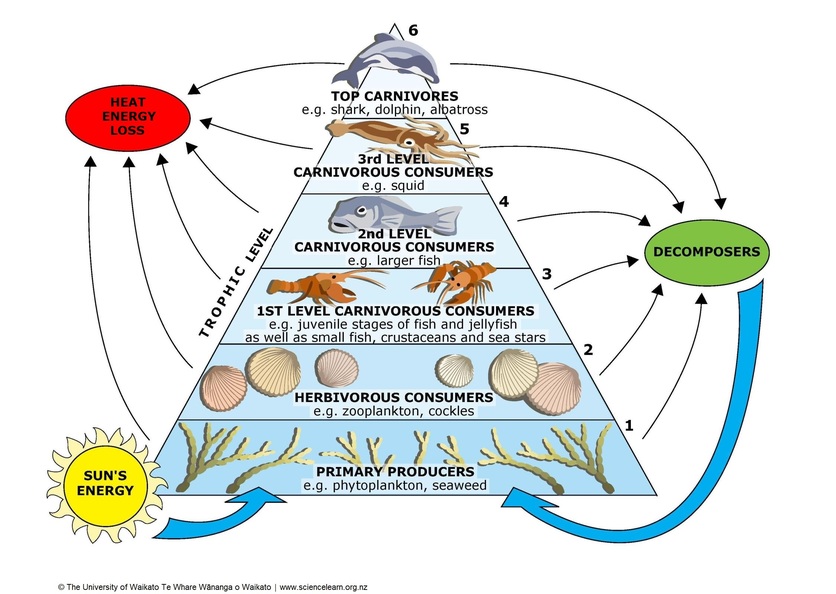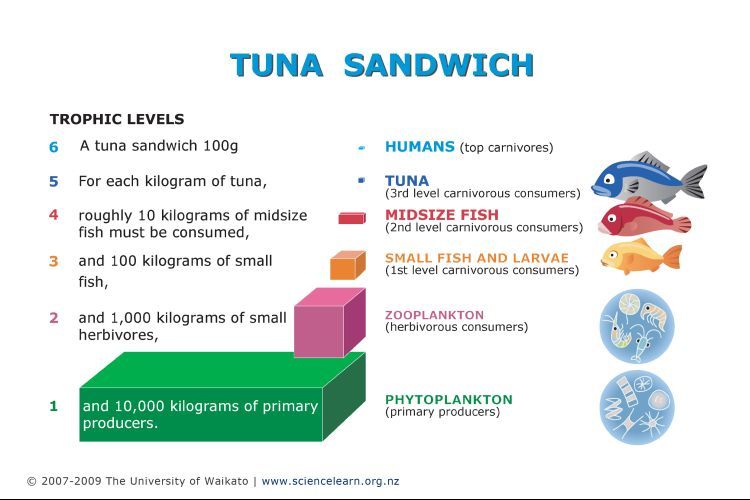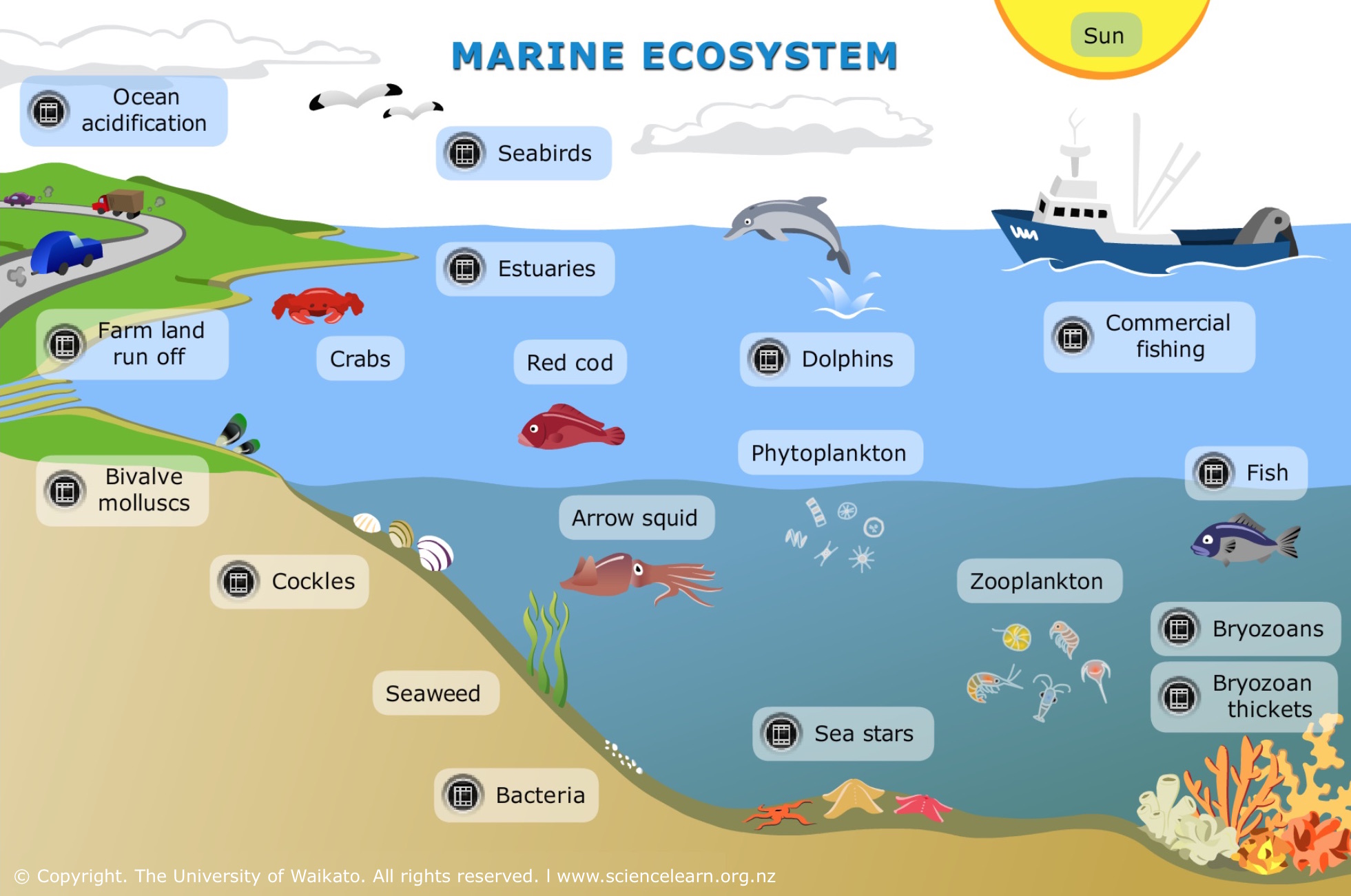Feeding relationships are often shown as simple food chains – in reality, these relationships are much more complex, and the term ‘food web’ more accurately shows the links between producers, consumers and decomposers
A food web diagram illustrates ‘what eats what’ in a particular habitat. Pictures represent the organisms that make up the food web, and their feeding relationships are typically shown with arrows. The arrows represent the transfer of energy and always point from the organism being eaten to the one that is doing the eating.
Trophic levels
Organisms in food webs are commonly divided into trophic levels. These levels can be illustrated in a trophic pyramid where organisms are grouped by the role they play in the food web. For example, the 1st level forms the base of the pyramid and is made up of producers. The 2nd level is made up of herbivorous consumers and so on. On average, only 10% of the energy from an organism is transferred to its consumer. The rest is lost as waste, movement energy, heat energy and so on. As a result, each trophic level supports a smaller number of organisms – in other words, it has less biomass. This means that a top-level consumer, such as a shark, is supported by millions of primary producers from the base of the food web or trophic pyramid.
Food webs throughout the world all have the same basic trophic levels. However, the number and type of species that make up each level varies greatly between different areas and different ecosystems.
Producers
Producers are described as autotrophic, which means they are able to make their own food. Just like producers on land, producers in the marine environment convert energy from the sun into food energy through photosynthesis. Phytoplankton are the most abundant and widespread producers in the marine environment. Other producers include seaweeds (a type of macroalgae) and seagrasses (the only flowering plant found in marine environments). New Zealand has only 1 species of seagrass but many species of seaweed.
Consumers
Consumers are described as heterotrophic, which means they are unable to make their own food and rely on consuming other organisms or absorbing dissolved organic material in the water column.
Consumers are divided into herbivores and carnivores and are typically further divided into 1st, 2nd or 3rd level consumers. For example, many zooplankton in the marine environment are herbivorous consumers. They form the 2nd level of the trophic pyramid and consume phytoplankton. Zooplankton are eaten by the 1st level carnivorous consumers, which includes juvenile stages of larger animals like fish and jellyfish as well as small fish and crustaceans. 2nd and 3rd level carnivorous consumers include larger fish and some species of squid and octopus. Predators at the top level of the trophic pyramid include animals like sharks and dolphins. However, not all top marine predators live in the sea. The albatross is an important predator at the top of the marine food web in Otago. Humans are also top-level consumers in the marine food web.
Decomposers
Decomposers exist on every trophic level. They are mainly bacteria that break down dead organisms. This process releases nutrients to support the producers as well as the consumers that feed through absorbing organic material in the water column. This process is very important and means that even top-level consumers are contributing to the food web as the decomposers break down their waste or dead tissue.
Changes to food webs
The effect of removing or reducing a species in a food web varies considerably depending on the particular species and the particular food web. In general, food webs with low biodiversity are more vulnerable to changes than food webs with high biodiversity. In some food webs, the removal of a plant species can negatively affect the entire food web, but the loss of one plant species that makes up only part of the diet of a herbivorous consumer may have little or no effect.
Some species in a food web are described as ‘keystone’ species. A keystone species is one that has a greater impact on a food web than you would expect in relation to their abundance. The removal of a keystone species characteristically results in a major change, in the same way that removing a keystone from an arch or bridge could cause the structure to collapse.
In Fiordland, the New Zealand sea star is a keystone species that controls the numbers of the species it feeds on, for example, mussels. If the sea star is removed, this can cause a large increase in the numbers of mussels, and this has flow-on effects throughout the food web.
Many scientists investigate food webs in order to better understand how they may be affected by human impacts such as fishing, pollution and tourism.
Useful links
Listen to this Radio New Zealand programme Sea Lions As Food Web Ambassadors. Lucy Jack is hoping that her research will give insights into marine food webs and how they’ve changed over time.
Learn about Trophic level: definition, categories, structure, examples and importance on Biology Online.



